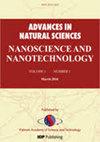Biological and physicochemical characterization of carbonated hydroxyapatite-honeycomb-polyethylene oxide bone scaffold fabricated using the freeze-drying method
IF 2.1
Q3 MATERIALS SCIENCE, MULTIDISCIPLINARY
Advances in Natural Sciences: Nanoscience and Nanotechnology
Pub Date : 2024-08-16
DOI:10.1088/2043-6262/ad6b7b
引用次数: 0
Abstract
In this work, a carbonated hydroxyapatite/honeycomb/polyethylene oxide (CHA/HCB/PEO) scaffold was fabricated using the freeze-drying method. The CHA bioceramic component was synthesized from oyster shells using the precipitation method. HCB and PEO act as reinforcing materials that influence the physicochemical properties of the scaffold and as antibacterial agents on the scaffold. The CHA produced was B-type, confirmed by Fourier transform infrared (FTIR) and x-ray diffractometer (XRD) spectra of the CHA. FTIR analysis of the scaffold demonstrated the presence of functional group vibrations originating from PEO and HCB, affirming the successful application of the freeze-drying method, which preserved the polymer content within the scaffold during the evaporation process, thus facilitating pore formation. The XRD results show that a lower CHA concentration is associated with a smaller size of the scaffold crystallites, potentially inducing dislocations favorable for cellular proliferation. The porosity of the formed scaffold is in the ideal range of >60% with CHA concentration of 5 and 10 wt%. The size of the pores that formed on the scaffold was 3–69 μm, classifying them within the micropore category. The利用冷冻干燥法制作的碳化羟基磷灰石-蜂窝状聚氧化乙烯骨支架的生物和理化特性分析
本研究采用冷冻干燥法制作了碳化羟基磷灰石/蜂窝/聚氧化乙烯(CHA/HCB/PEO)支架。CHA 生物陶瓷成分是用沉淀法从牡蛎壳中合成的。HCB 和 PEO 可作为增强材料影响支架的理化性质,也可作为支架上的抗菌剂。CHA 的傅立叶变换红外光谱(FTIR)和 X 射线衍射仪(XRD)光谱证实,所制备的 CHA 为 B 型。对支架进行的傅立叶变换红外分析表明,存在源自 PEO 和 HCB 的官能团振动,这证明冷冻干燥法的成功应用,该方法在蒸发过程中保留了支架中的聚合物成分,从而促进了孔隙的形成。XRD 结果表明,较低的 CHA 浓度与较小的支架晶粒尺寸有关,可能会诱发有利于细胞增殖的位错。CHA 浓度为 5 和 10 wt% 时,形成的支架孔隙率在 60% 的理想范围内。支架上形成的孔隙大小为 3-69 μm,属于微孔类别。体外抗菌测试结果表明,该支架可抑制金黄色葡萄球菌和大肠杆菌。值得注意的是,含有 10 wt% CHA 的支架具有更大的抑菌区直径,对金黄色葡萄球菌的抑菌区直径为 10.083 ± 0.104 毫米,对大肠杆菌的抑菌区直径为 10.517 ± 0.247 毫米。支架中的 MTT 检测和细胞形态 MC3T3E1 结果表明,CHA/HCB/PEO 支架无毒性,可促进细胞附着和增殖。浓度为 31.25 μg ml-1 时,支架的细胞存活率为 96.23%,IC50 值为 16144 μg ml-1。因此,CHA/HCB/PEO复合材料可作为骨组织工程支架制造的替代材料。
本文章由计算机程序翻译,如有差异,请以英文原文为准。
求助全文
约1分钟内获得全文
求助全文
来源期刊

Advances in Natural Sciences: Nanoscience and Nanotechnology
NANOSCIENCE & NANOTECHNOLOGYMATERIALS SCIE-MATERIALS SCIENCE, MULTIDISCIPLINARY
自引率
4.80%
发文量
0
 求助内容:
求助内容: 应助结果提醒方式:
应助结果提醒方式:


